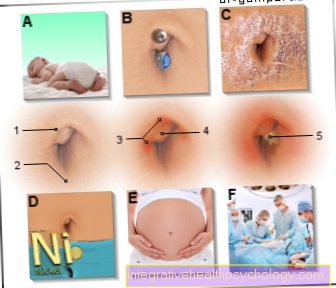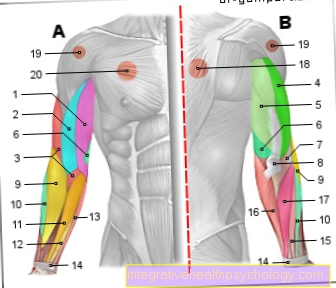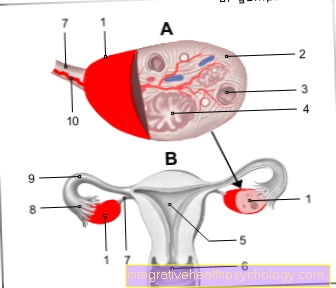This is how colon polyps are removed
introduction
Colon polyps are growths on the intestinal wall. The polyps are also called colorectal adenomas and can come in different forms.
The polyps themselves are benign, but they can degenerate into malignant growths in the course of the process, so they are often the precursors of colon cancer. Colon polyps are discovered during the colonoscopy; they can usually be removed during the colonoscopy. The early detection of colon cancer can prevent benign colorectal adenomas from developing into malignant colorectal carcinomas, i.e. colon cancer. By participating in the program for colorectal cancer early detection, the risk of colorectal cancer can be reduced, as early stages are removed.
Read more on the topic: Colon cancer screening

Prepare for colon polyp removal
Preparing for colon polyp removal essentially consists of preparing for the colonoscopy.
In preparation for this examination, the bowel must be thoroughly cleaned. To do this, the discharge must be started the day before the examination. To do this, laxatives are used, which essentially consist of salts that the body cannot absorb. The salt draws water from the body into the intestine through osmosis. This effectively excretes the intestinal contents. You will receive precise instructions on how to perform the colon cleansing from the practice performing the examination.
Because laxative measures remove large amounts of water from the body, it is important to drink large amounts of clear fluids. It is also important to avoid food for a few days before the examination that is difficult to digest and that may stick to the intestinal wall. These are fibrous foods and vegetables with a hard-to-digest skin, like tomatoes. No more food should be consumed after noon before the examination.
Read more on the topic: Prepare for a colonoscopy
What are the options for removal?
The most common method of colon polyp removal is performed with a sling. This loop can be brought up to the polyp through a working channel of the colonoscope. The colonoscope is the long flexible camera that is inserted through the anus. The noose is then wrapped around the polyp and tightened. The loop is then supplied with electricity, which heats the tissue and the polyp is cut off. The polyp must then be recovered and sent to the pathology department for examination so that it can be determined whether there are cancer cells in the polyp.
The snare method is not possible with some types of polyps, another option is laser removal, where laser light can remove the polyps in a targeted manner. This method can also be performed as part of a colonoscopy. However, if these less invasive measures are not possible, for example because of the size or the fact that it has grown too deeply into the intestinal wall, the polyp must be surgically removed. Some new methods are being tested that will enable endoscopic removal even in the case of polyps that otherwise only have to be removed surgically.
Read more on the topic: Colon polyps
These risks exist
The main risk of bleeding is the colon polyp removal. With superficial polyps, where removal is not a major problem, this complication is very rare. By sclerosing the blood vessels during removal, bleeding is avoided. However, if the polyp lies deeper in the intestinal wall and is more difficult to remove, bleeding is more likely because blood vessels are injured, which may be larger than superficial polyps.
On the other hand, another complication, the injury to the intestinal wall, i.e. a perforation, is more dangerous. Of course, removing the polyps will injure a piece of the intestine, but with superficial polyps the injury is limited to the inner layer. However, it can rarely happen that a hole appears in the entire intestinal wall. This allows bacteria from the intestines to enter the abdomen and cause severe peritonitis. If a hole is discovered immediately and an operation for therapy initiated immediately, the risks are manageable. The hole can be closed with an intestinal suture and antibiotic therapy is initiated.
Further complications arise from the colonoscopy itself, including injury to the sphincter muscle, which although rarely occurs, has unpleasant consequences for the patient.
Read about this too: Risks of a colonoscopy
Duration of the distance
With uncomplicated polyps, removal does not take very long.
A normal colonoscopy takes about 15 minutes to half an hour. The duration also varies depending on the number of polyps to be removed. If the removal is more complicated, the procedure will take longer. If a polyp has to be surgically removed, this operation may take a certain amount of time, depending on the extent, but it is difficult to determine. A surgeon who performs this procedure on a regular basis has experience and can estimate the approximate duration of the procedure.
Length of hospital stay
When removing polyps, which is carried out as part of a colonoscopy, no hospital stay is normally necessary.
However, if problems arise during this procedure and an emergency operation has to be carried out, a hospital stay of a few days is necessary. A previously planned operation to remove polyps will also require a short hospital stay in order to detect complications early.
Is that also possible on an outpatient basis?
An outpatient removal of the polyps is possible if the removal is most likely only associated with a low risk of complications.
This is the case when the polyps are small and do not grow into the intestinal wall. Another obstacle to the outpatient removal of polyps is too large a number of polyps. In this case, surgical removal is more likely to be carried out, which is associated with an inpatient stay.
Follow-up treatment - this must be observed
The follow-up care required after colon polyp removal depends on whether the examination of the adenoma has revealed any malignant cancer cells.
In general, once a polyp has been discovered, people are more likely to develop polyps again. Therefore, colonoscopies must be performed more often in these people than in the general population. If no malignant cells were found when examining the polyp, another colonoscopy is performed after 3-5 years. However, if malignant cells have been detected, a colonoscopy must be carried out again after six months. This checks whether cancer cells have been left behind and whether the disease has progressed. If this is not the case, the intervals between colonoscopies will increase again.
You might also be interested in the topic: How is colon cancer diagnosed?
Length of sick leave
If the polyps are performed as part of a colonoscopy, the risk of complications is low and the patient can quickly cope with everyday life again. In this case, a sick leave can take one to three days, depending on the extent of the intervention.
Above all, sick leave is important if narcotics are used during the examination. On the day of the examination, the patient must not drive or operate heavy machinery. If a major intervention is initiated that involves hospitalization, the incapacity for work can last much longer. Even after the stay in the hospital, a phase of rehabilitation may still be necessary, which requires a sick leave.
Read more on the topic: Short anesthesia with propofol for a colonoscopy



















.jpg)









